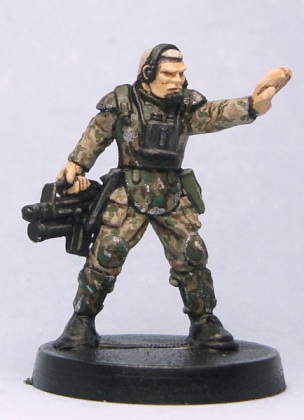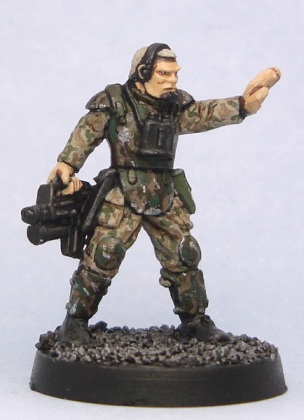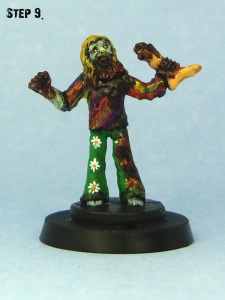After posting about the Colonial Marine that I painted, I got a few requests for a tutorial on how I painted him. Since I was looking for one when I started, and ended up doing a bit of research on the subject, I figured I’d make a tutorial myself. Probably spurred on by the release of the new edition of Space Hulk, there’s a surprisingly large number of people gaming the Aliens universe, so I hope this is of use to someone. And even to those not painting Colonial Marines, this tutorial details a simple way of painting a fairly generic scifi trooper. Since I’m not a pro painter by a long shot, this tutorial should be fairly easy to follow. There’s no wet-blending, NMM or fancy stuff like that.
Throughout this tutorial you can click on photos to enlarge them in a new tab. As you’ll probably notice, the colours vary from photo to photo a bit. This is due to the fact that I shot the photos whenever I did some painting, meaning some were taken in bright daylight while others were taken in the middle of the night, not to mention using wrong camera settings etc. Photoshopping them all consistent would’ve been a huge chore, so I chose to live with them. I hope you can too.
Step one – Miniature
You can’t have a tutorial without a miniature to paint. As I posted earlier, I’ve picked Mark Copplestone’s scifi troopers (available from em4, Copplestone Castings and Mirliton) as my Colonial Marines. This particular miniature is a a trooper from em4.

The unpainted trooper
Step two – Research
The second thing I did was look for reference material. It’s a surprisingly simple step that is often neglected. Simply by browsing pictures of what you’re about to recreate helps you immensely. With Google’s image search, this couldn’t really be any simpler. I simply typed in “colonial marine” followed by “armor/weapons/bdu/etc”. If you’re really lazy, you can just click here. The internet is full of people collecting movie props and replicas, which helps miniature painters to no end.
These are some of the (shamelessly plundered – will take down on request) pictures I went with:

Colonial Marine BDU
Step three – Basecoat
Em4’s miniatures come ready with a grey basecoat. While this is usually really helpful, I’m completely rubbish at painting over anything other than a black basecoat. This was quickly remedied with a touch of black paint.

Black basecoat added
Step four – BDU base colour
Next I painted the BDU (Battle Dress Uniform) with VGC (Vallejo Game Color) Khaki. Nothing special here, being neat helps.

BDU painted VGC Khaki
Step five – Armour base colour
I then painted the trooper’s armour, armour straps and the pouches on his belt with VGC Cayman Green. As you may have noticed, what I’d interpreted as being the collar of the model’s BDU turned out to be a part of the armour. Probably. Don’t you just hate things like this?

Armour painted VGC Cayman Green
Step six – Skin and hair base colours
Next came the skin, using Citadel’s old Bronzed Flesh. This is an old paint that I have, and I believe it might’ve been licensed from Coat d’Arms. The hair was painted with VGC Khaki.

Skin and hair painted with Citadel Bronzed Flesh and VGC Khaki
At this point our trooper is starting to look something like an actual, painted miniature, albeit a cheap, prepainted plastic one. Now we start the fun(-ish) stuff, or in other words:
Step seven – BDU camo first colour
Painting camo tends to put people off for some reason. I don’t really understand why! It’s time-consuming of course, but it’s also really simple. I started with Citadel Graveyard Earth, and simply painted small irregular patterns/blotches on the BDU. I left fairly much empty space between the patterns, since I’d still need to squeeze in a second colour.

First BDU camo patterns with Citadel Graveyard Earth
Step eight – BDU camo second colour
In this step I simply repeated the procedure of the previous step, using VGC Cayman Green. I tried to be as neat as possible, and not have the two camo colours overlap. And just like that, we have camouflage! As you might notice, for this picture I remembered to flick on my camera’s correct settings.

Second BDU camo patterns with VGC Cayman Green
Step nine – Brown ink
To darken the armour a bit and to better bring out the folds in the BDU, I next gave the armour a thin coat of Citadel Brown ink and painted some of it in the cloth folds as well. The armor will usually look a bit messy. Don’t worry. It’s just a phase it’s going through.

Citadel brown ink on armour and BDU folds
Step ten – Armour camo first colour
Checking the reference photos above shows that there’s camo on the armour as well. The patterns are a bit larger, so I took this into account. I used the same Citadel Graveyard earth paint as on the BDU. Note that I didn’t paint any camo on the armour straps.

First armour camo patterns with Citadel Graveyard Earth
Step eleven – Armour camo second colour
Next I finished off the armour camo by adding a second colour. The paint I used is an old Coat D’Arms one, and I have absolutely no idea of its name. It’s a darkish green, feel free to improvise to your own taste.

Second armour camo patterns with dark green
Step twelve – Armour weathering
A Colonial Marine’s armour is bound to get scuffed up a bit as he goes about the galaxy gunning down things, so my last step in painting armour was adding a little damage. I used Miniature Paints Chainmail, don’t know if you can find it anywhere. Any darker silvery metallic will do, though. I painted damage along the edges of armour as well as random scratches. Again the reference pictures are a great help.

Armour weathering with Miniature Paints Chainmail
Step thirteen – Skin shading
Since the skin was still flat at this point, my next step was to apply some Citadel Flesh Wash to the recesses, like between fingers, eyesockets etc.

Skin shaded with Citadel Flesh Wash
Step fourteen – Skin and hair highlighting
I finished off the skin with a highlight of Citadel Bronzed Flesh mixed with VGC Bone White, and the hair with a mix of VGC Khaki and VGC Off White. I like my highlights very subdued, and am not really a fan of the style of highlighting to pure white.

Skin and hair highlighted with lighter versions of base colours
Step fifteen – Highlighting the equipment
I have to make a confession here. I hate highlighting black, and am sick and tired of it, especially after these guys. Because of that, I really took an easy way out here, and simply highlighted every black item (weapon, headset, boots, gun holster, binoculars) on the Marine with Citadel Codex Grey and smoothed it down a bit with Citadel Black Ink. It’s quick and easy and delivers a good enough result. The same mentality went into highlighting the green ammo pouches. I mixed a lighter highlight colour from VGC Cayman Green and VGC Off White, and highlighted the edges. I didn’t want the equipment to be focal points in the mini, so I didn’t spend much time and effort on them.

Black equipment highlighted with Citadel Codex Grey and dulled down with Citadel Black Ink, green equipment with lighter shade of base colour
Step sixteen – Finishing touches
Nearly there! I painted the eyes, based the model (sand, Citadel Fortress Grey, Citadel Black Ink, drybrush with Fortress Grey) and gave it a coat of gloss varnish followed by a coat of matt varnish to take away the shine.

The finished model
And there you go! A happy little Colonial Marine ready to die gruesomely in the hands of your extra terrestrial of choice. I’d love to get feedback on this post. Of course, if you use this tutorial, I definitely want to see the results!
That’s it. Game over, man, game over.





































